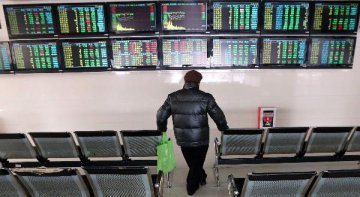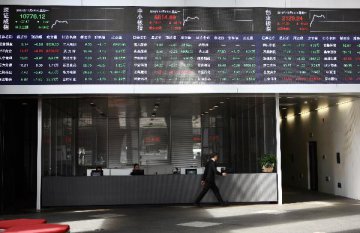
Refinancing scale was eight times of IPO in 2016, and set a historic high; shareholdings of 360 billion yuan had been decreased, and “selloff-style” shareholding decrease frequently happened, the Xinhua News Agency reported on Jan. 18. “Extremely-massive” refinancing and aggressive shareholding decreases will become two major “hemorrhagic spots”. How do we deal with them?
“Extremely-massive” refinancing: A shares bearing pressure arouses concerns
Since 2017, A shares have constantly fluctuated and consolidated in a narrow range, it is even rare to see “consecutive declines for eight trading days” of ChiNext Board index, and many people blame IPO normalization for this. Meanwhile, the market focuses more on “extremely-massive” refinancing and expectation on the following shareholding decrease after shares allowed as tradable.
IPO and refinancing (referring to cash) totaled at 1.33 trillion yuan in 2016, up 59 percent year on year, and especially, refinancing scale set a historic high, according to data disclosed by China Securities Regulatory Commission (CSRC). Fundraising scale for new shares was 147.6 billion yuan in 2016, institutional data shows. Based on rough statistics, in the year with the biggest financing scale in the history, market supply through refinancing was eight times of that for IPO.
In fact, similar situation constantly happened in the past years. The overall financing scale of A-share market in 2014 and 2015 reached 749 billion and 1,521.5 billion yuan respectively, and especially, the IPO proportion was 8.9 percent and 10.4 percent, statistics shows. Based on this, the refinancing scale averagely accounts for over 90 percent of the total A-share fundraising scale in the latest three years.
“No matter overall financing or average level of a single stock, capital distribution pressure worried by the market may greatly come from over big refinancing scale and concerns on the following shareholding decrease after shares are tradable”, Shan Xiangshuang, CEO of China Science & Merchants Investment Management Group, said.
The refinancing mode of listed companies is simple now, and many prefer additional issuance, in the view of Dong Dengxin, head of Finance & Securities Research Institute under Wuhan University of Science & Technology. “A huge scale of additional issuance seems to become a universal way to raise massive funds, but the price will be finally paid by stock investors.” Such situation must be restrained, Dong said.
Aggressive shareholding decreases: gaining liquidity through “selloff” to challenge bottom line
Besides “extremely-massive” refinancing, a large number of shareholding decreases becomes another factor causing capital outflow in the A-share market.
In the first half year of 2015, bullish market trend caused frequent shareholding decreases, and substantial shareholders did so to gain liquidity of 500 billion yuan. After dramatic fluctuation, regulatory authorities proposed clear rules at the beginning of 2016 regarding to shareholding decrease behaviors by substantial shareholders and senior management of listed companies. But just in such a year when the market needed further recovery, the shareholdings of around 360 billion yuan still had been decreased.
Rational shareholding decrease based on judgment for the market trend or self-demand for funds is understandable. But in just one year, many such behaviors were carried out through block trade to avoid related supervision, and cases ignoring the regulation and breaking the rules were not rare. Kinds of aggressive shareholding decreases make bottom line of the market and each party, including regulators, face challenges.
In particular, shareholders of about 20 listed companies successively announced to “dump” the shareholdings, bringing in panic market sentiment and also greatly-negative impact.
“Substantial shareholders should have faced the troubles together with listed companies, but they decreased the shareholdings or even dumped the shares one by one; such behaviors will undoubtedly hit the investor confidence in the listed companies or even the overall market”, Qiu Yanying, research director of VStone Asset Management, pointed out.
Stepping in 2017, A-share market may still face such troubles. This year, 202.8 billion shares of 1,030 listed companies in Shanghai and Shenzhen bourses will become tradable, and their market value is estimated to reach 2.88 trillion yuan roughtly, based on statistics of Southwest Securities. The market value of shareholdings announced to be decreased in 2017 will be around 340 billion yuan, based on shareholding-decrease proportion of 12 percent announced for 2016.
It concerns that the funds from a quite big scale of shareholding decrease will be used for consumption, financial management, or be transferred overseas, instead of starting up a new business or reinvestment. It will expand the outflow of capital market, and also make real economy constantly face such risk, some insiders thought.
Urgent to form health A-share market structure to prevent massive capital outflow
A shares bear a major task of raising direct financing proportion and optimizing resource allocation. Facing double-hit from “extremely-massive” refinancing and aggressive shareholding decrease, insiders call for regulators to improve and strictly execute related regulations as soon as possible, and rationally guide and standardize the said two behaviors.
On one side, with a premise of supporting enterprises’ financing demands and also considering market capability, refinancing pace should be properly reduced through higher standard and other ways to ease the future shareholding decrease pressure after shares involved in refinancing become tradable. Meanwhile, refinancing scale in near future should be disclosed in time to reinforce the expectation guidance for the market.
On the other side, policies related to substantial shareholders of listed companies decreasing shareholdings should be further improved with higher information disclosure requirements; shareholding decrease policy and commitment for IPO should be improved, too. Substantial shareholders should be restrained when they crazily decrease the shareholdings, especially “selloff” behaviors, and they should also be strictly punished if their behaviors break the rules.
It is worthy of noting that requirements for issuer are low with insufficient transparency, private placement as first choice of refinancing exposes the over-fundraising problem, and many issues are also disclosed, like hidden and usually rule-breaking cooperation among institutions just for interests, which all arouse attention of regulatory authorities with new standards and policies in process.
Intensifying the regulations has always been a requirement for sound and stable development of capital market. Since 2017, shareholders of many listed companies, such as Shenzhen Jinxinnong Technology Co., Ltd. (002548.SZ), Hanwang Technology Co., Ltd. (002362.SZ) and Shenyang Jinbei Automotive Company Limited (600609.SH), have been punished by regulators, as their shareholding decrease behaviors break the rules. It shows supervision on such behaviors of substantial shareholder will be stricter.
Better playing the role of capital market to optimize the resource allocation relies on health structure of capital market. For A shares, besides improving new share issuance & delisting system and rebuilding metabolism function, it has been urgent to greatly restrict crazy refinancing and aggressive shareholding decrease behaviors.
Translated by Jelly Yi






















Latest comments